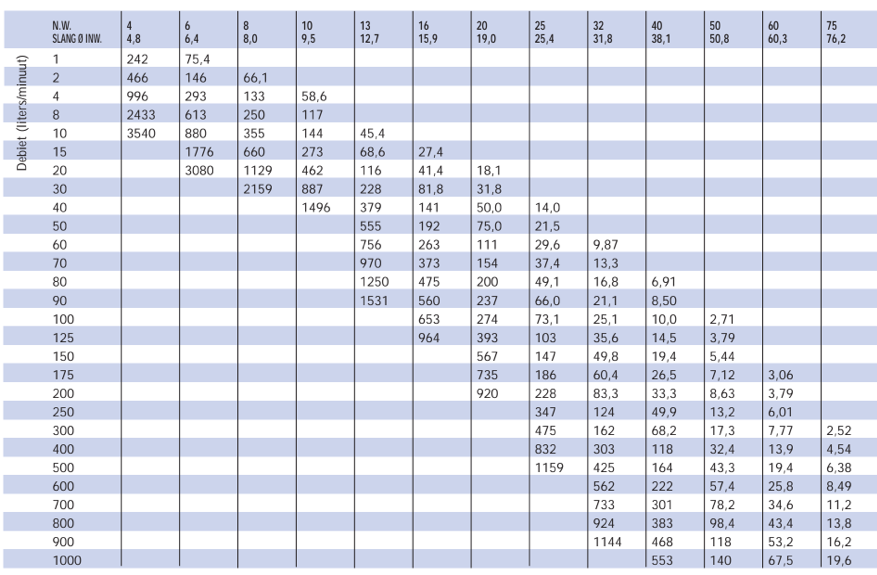How do you determine the diameter of a hydraulic hose?
When building a new machine, you have to make a lot of choices. For example, how big should the hoses be? How do you determine the diameter of a hydraulic hose? In this article we give you a handy way to determine the size of new hydraulic hoses.
Hose diameter
Choosing the right diameter of hydraulic hose depends on the volume - in litres -which must pass through the hose and at what speed. Look at the table below. The point of intersection where the dotted line crosses column B indicates the correct diameter of a hose. In column A you will see the number of litres which must pass through per minute, and in column C the speed at which this has to happen. As you can see, different speeds are possible. This depends on the application. For example, for a suction hose (Z, in the table) this is 0.6-1.25 m/s and for a pressure hose 2.5 to 4.5 m/sec.

Pressure loss in hoses
The pressure drop of a hose depends on the inside diameter and the amount of litres passing through the hose. The table below shows the pressure loss in millibars (mbar). This is based on a hose length of 1 metre, with no couplings attached to the hose. Always check that the total hose and its pressure drop are suitable for use in the system.

Hose mounting guidelines
Now that you've determined the right diameter, it's time to mount the hose. When assembling hoses, it is important to take a few things into account. The guidelines are described below.
1. Hose length
Changes in length, which occur under pressure, require the hose to have extra length. It is important to use angled connections and pipe brackets that ensure good guidance for the extra length of hose. Avoid wear, crushing and a bending radius which is too low. The length must be long enough to compensate for the movement of any moving parts attached to the hose.

2. Hose radius
To prevent kinks and flow reduction in the hose, the bending radius of a hose must be above the required minimum bending radius. In addition, an unbent length of approximately 6 times the hose diameter from the coupling is recommended for a bent hose. The minimum unbent length is 1.5 times the hose diameter. If the bending radius is below the required minimum, use angled connections to avoid sharp bends.

3. Hose bending
Avoid bending directly behind connecting parts. Different hoses are under different degrees of pressure, therefore do not bend and do not clamp high-pressure and low-pressure lines together.

4. Rotating hose
What is the best way to prevent a hose from twisting? Secure a hose at the point of change of two planes. A hose must be mounted straight. When the hose is mounted twisted, this increases the risk of hose failure when the hose is pressurised.

5. Hose connections
Keep the number of pipe wire connections to a minimum. Always use well-fitting connections. Avoid stress on the hose connections by using angled connections and ensure your installation method is logical and regular.

6. Hose routing
Avoid unnecessary contact of the hose with hot parts of the hydraulic system by using hose protection and pipe brackets. Use hose brackets to absorb changes in length caused by pressure. A hose protector will also protect the user against oil that could escape if there is any leakage.

Ask an expert
Follow the operating instructions for your hydraulic system closely at all times.
Unless you are trained and experienced, don’t make decisions alone - trust your dealer. You can also call an account manager or a product specialist at Kramp for reliable advice on everything to do with hydraulics – we will always be happy to help you.

